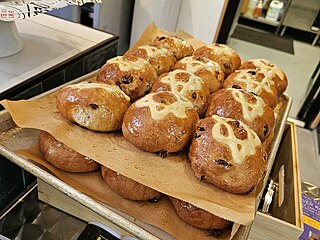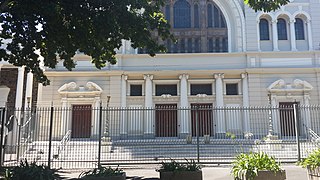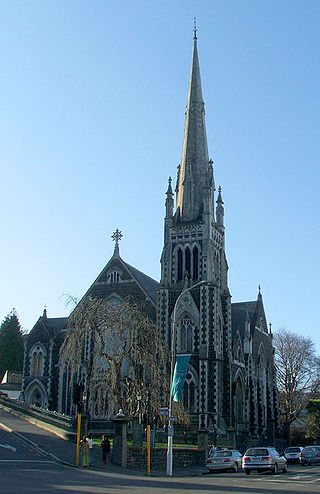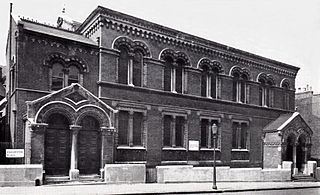
Selwyn College is a residential college affiliated to the University of Otago in Dunedin, New Zealand. It was founded by Bishop Samuel Tarratt Nevill as a theological college training clergy for the Anglican Church and as a hall of residence for students attending the university. It is named after George Augustus Selwyn, the first Bishop of New Zealand and is owned by the Anglican Diocese of Dunedin. It was opened on 15 January 1893. It was Otago's first residential college and on the model of an English university college it included students of all subjects. Women were admitted in 1983. The main building is listed as a Category II Historic Place. Selwyn is one of the most popular colleges in Dunedin, its 214 available places oversubscribed every year.

First Church is a prominent church in the New Zealand city of Dunedin. It is located in the heart of the city on Moray Place, 100 metres to the south of the city centre. The church is the city's primary Presbyterian church. The building is regarded as the most impressive of New Zealand's nineteenth-century churches, and is listed by Heritage New Zealand as a Category I structure.

Princes Street is a major street in Dunedin, the second largest city in the South Island of New Zealand. It runs south-southwest for two kilometres from The Octagon in the city centre to the Oval sports ground, close to the city's Southern Cemetery. North of The Octagon, George Street continues the line of Princes Street north-northeast for two and a half kilometres. Princes Street is straight but undulating, skirting the edge of the City Rise to its northwest. The part of the street immediately below The Octagon is the steepest section, as the road traverses an old cutting through Bell Hill.

Moray Place is an octagonal street which surrounds the city centre of Dunedin, Otago, New Zealand. The street is intersected by Stuart Street, Princes Street and George Street. Like many streets in Dunedin, it is named for a street in the Scottish capital Edinburgh.

Robert Arthur Lawson was one of New Zealand's pre-eminent 19th century architects. The Dictionary of New Zealand Biography states that he did more than any other designer to shape the face of the Victorian era architecture of the city of Dunedin. He is the architect of over forty churches, including Dunedin's First Church for which he is best remembered, but also other buildings, such as Larnach Castle, a country house, with which he is also associated.

The Sarajevo Synagogue is an Orthodox Jewish congregation and synagogue, located on the south bank of the river Miljacka, in Sarajevo, in Bosnia and Herzegovina. The synagogue was constructed in 1902 and is the only functioning synagogue in Sarajevo today. The congregation worships in the Ashkenazi rite.

New Zealand Jews, whether by culture, ethnicity, or religion, form with Hawaii (8,000–10,000), the joint-second largest (7,500–10,000) Jewish community in Oceania, behind Australia (118,000).

Caversham is one of the older suburbs (neighbourhoods) of the city of Dunedin, in New Zealand's South Island. It is sited at the western edge of the city's central plain at the mouth of the steep Caversham Valley, which rises to the saddle of Lookout Point. Major road and rail routes south lie nearby; the South Island Main Trunk railway runs through the suburb, and a bypass skirts its main retail area, connecting Dunedin's one-way street system with the Dunedin Southern Motorway. The suburb is linked by several bus routes to its neighbouring suburbs and central Dunedin.

The Gardens Shul, formally the Cape Town Hebrew Congregation (CTHC), also called the Great Synagogue, is a Modern Orthodox Jewish congregation and synagogue, located in the Company Gardens, in the Gardens neighborhood of Cape Town, South Africa. The congregation was established in 1841, making it the oldest Jewish congregation in South Africa.

Knox Church is a notable building in Dunedin, New Zealand. It houses the city's second Presbyterian congregation and is the city's largest church of any denomination.

Congregation Adath Israel Brith Sholom is a Reform Jewish congregation and synagogue located at 5101 US Hwy 42, in Louisville, Kentucky, in the United States.

Congregation Ahavath Achim is a Modern Orthodox Jewish congregation and synagogue, located in Fairfield, Connecticut, in the United States.

Bayswater Synagogue was an Orthodox Jewish congregation and synagogue located in Chichester Place, Paddington, in the City of Westminster, London, England, in the United Kingdom. The congregation worshipped in the Ashkenazi rite.

Liverpool Reform Synagogue is a Reform Jewish congregation and synagogue in Liverpool, England. It is a member of the Movement for Reform Judaism.
The Temple Israel is a Progressive Jewish congregation and synagogue, located in Hillbrow, a suburb of Johannesburg, in the district of Gauteng, South Africa. Designed by Hermann Kallenbach in the Art Deco style, the synagogue was completed in 1936 and is the oldest of eleven Progressive synagogues in South Africa. The synagogue is classified as a provincial heritage site. The congregation is affiliated with the South African Union for Progressive Judaism (SAUPJ), which is part of the World Union for Progressive Judaism (WUPJ).
Beit Emanuel, formally the Temple Emamuel, is a Progressive Jewish congregation and synagogue, located in Parktown, a suburb of Johannesburg, in the district of Gauteng, South Africa. The synagogue was established in 1954 and is one of the largest Progressive Jewish congregations in South Africa. It is an affiliate of the South African Union for Progressive Judaism (SAUPJ), which is part of the World Union for Progressive Judaism (WUPJ).
Louis Boldini was an Italian-born architect who made considerable contributions to the architecture of Dunedin, New Zealand and Victoria, Australia.

St Andrew's Presbyterian Church was a prominent church in Dunedin, New Zealand. Designed by pre-eminent Dunedin Robert Lawson it was constructed in 1870 to serve a rapidly developing area of the city which became notorious for its slum housing, poverty and crime which led to it being referred to as the "Devil's Half-Acre" from 1873 onwards. The church is best known for its long time crusading minister the Reverend Rutherford Waddell. Waddell's 'Sin of Cheapness' sermon which was a landmark in New Zealand's social and labour history was delivered from its pulpit. It eventually closed as a place of Presbyterian worship in 1978 and after briefly serving as a place of worship for the Word of Life Pentecostal Church it was purchased by the Coptic Orthodox Church in 2000, who renamed it the Archangel Michael Coptic Orthodox Church.
















